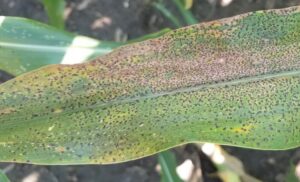This disease is a relatively new disease to Indiana. So far, it has mostly affected field corn. However, tar spot was recently observed on sweet corn. This article will discuss the symptoms, biology and management of tar spot of sweet corn.
Tar spot causes dark, mostly circular lesions on the leaves, stalks and husks of field and sweet corn (Figure 1). Each of these lesions is capable of producing thousands of spores. Tar spot is favored by relatively cool temperatures (60-70 F), 75% or more relative humidity and over 7 hours of leaf wetness. Because of the optimum temperatures, the disease is often found in northwest Indiana. The fungal pathogen, Phyllachora maydis, may survive on infested corn residue. This should be a factor in favor of most sweet corn growers since most fields are conventionally tilled instead of low or no-till, which are common in field corn.
There are no field corn hybrids that are resistant to tar spot, but growers have found that some hybrids are less susceptible to tar spot than others. Unfortunately, no information about the host resistance of sweet corn hybrids exists. Nevertheless, growers may learn which sweet corn hybrids to avoid with time.
Fungicides offer a possible management option. However, little research has been done on tar spot of sweet corn and fungicides. Therefore, I will rely on field corn information.
When to spray—again, I am relying on field corn information from Darcy Telenko, Purdue University. Dr. Telenko has found that effective fungicide applications are made between tassel emergence (VT) and blister stage (R2). Usually, only a single application is necessary. So, for most Indiana sweet corn growers, it is too late to make an effective fungicide application. In addition, since most growers are in the midst of harvest, the Restricted Entry Interval (REI) and Pre-Harvest Interval (PHI) will make many fungicide applications unworkable. However, sweet corn growers who have late crops may want to consider fungicide applications.
The following is a list of fungicides that I have put together that are labeled for both sweet corn and tar spot. In addition, I have only listed products with good or very good ratings from the crop protection management bulletin CPN-2011-W (cropprotectionnetwork.org).
- Trivapro 2.21 SE®; FRAC group 7, 11, 3; Rate 13.7 fl oz/A; 12 hour REI, 14 day PHI.
- Lucento®; FRAC group 3, 7; Rate 3-5.5 fl. oz./A; 12 hour REI, 30 day PHI.
- Veltyma®; FRAC group 3, 11; Rate 7-10 fl. oz./A; 12 hour REI, 30 day PHI.
- Revytek®; FRAC group 3, 7 11; Rate 8-15 fl oz/A; 12 hour REI, 21 day PHI.
- Delaro 325 SC®; FRAC group 3, 11; Rate 8 fl oz/A; 12 hour REI, 0 day PHI.
- Delaro Complete®; FRAC group 3, 7, 11; Rate 8 fl oz/A; 12 hour REI, 0 day PHI.
- Miravis Neo®; FRAC group 3, 7, 11; Rate 13.7 fl oz/A; 12 hour REI, 14-day PHI.
If it is too late to apply fungicides this year, what measures should one take?
- Avoid highly susceptible sweet corn hybrids. Since we don’t have much information about sweet corn hybrids, growers will have to avoid hybrids that have given them problems in the past.
- Next year, consider fungicides. For fungicides to be effective, they would have to be applied between tassel emergence and blister stage.
- Manage irrigation. Avoid overhead irrigation in situations where tar spot might be a problem.
- Rotate to other crops when possible.
- Manage residue. It is not clear how important residue is in tar spot survival between seasons. But it is a safe bet that conventional tillage is less likely to harbor tar spot between seasons.
- Scout for tar spot now and send in possible samples for an official diagnosis. This way, you will know where the disease may show up next year.
Fungicide applications for tar spot will not be necessary every year. Wet weather will make fungicide applications more likely to be effective. Follow the tar spot epidemic here. More information about tar spot of field corn from Dr. Darcy Telenko’s lab can be found here.
